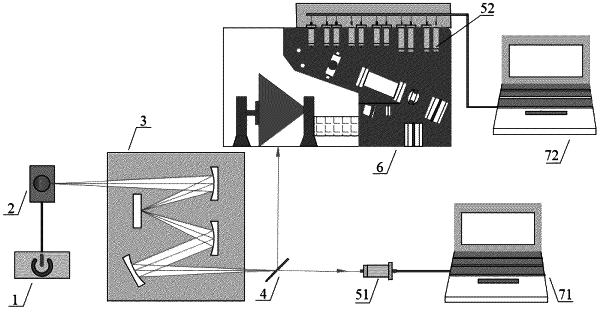| CPC G01S 7/497 (2013.01) [G01S 7/4817 (2013.01); G01S 17/89 (2013.01)] | 4 Claims |

|
1. A method for radiation calibration of airborne hyperspectral imaging LiDAR system, comprising the following steps:
S1. A monochromator in a spectrum calibration system emits optical signals of different spectrum values to scan the radar system, thus to obtain the bandwidth and central wavelength of each channel in the radar system;
S2. According to the return signal power PR (λ, z) in the hyperspectral LiDAR equation and the optical power PRef (λ) received by the target surface of the detector in the radar system under experimental conditions, a white diffuse reflection board is taken as the ground object target, and a ranging channel is used to measure the flying height of the radar system, thus to obtain the parameters in the return signal power PR (λ, z) and the reflection spectrum βG (λ) of the ground object detected by the hyperspectral imaging LiDAR system;
the step S1 is specified as follows:
S11. A spectrum calibration mechanism is constructed with a monochromator and a beam splitting mirror arranged in sequence; light coming out of the beam splitting mirror is split into two light paths; one directly enters a first detector, which outputs data to a first data acquisition system; the data processed in the first data acquisition system is used as the reference data; the other light path from the beam splitting mirror enters the airborne hyperspectral imaging LiDAR system subject to calibration via a rotating scan mirror, and a second detector in the radar system outputs data to a second data acquisition system;
S12. According to the spectral range of the airborne hyperspectral imaging LiDAR system, the monochromator emits, at a given precision of wavelength, optical signals at multiple wavelengths covering the spectral range of the radar system; the first data acquisition system and the second data acquisition system obtain a first current signal value L and a second current signal value I′n corresponding to the optical signal at a wavelength of λn, and determine the responding channel in the first detector when the optical signal is input;
S13. After the optical signals of all wavelengths are fully input, the spectral range of each channel is obtained in the radar system, the central wavelength λNCE of each channel is obtained according to current ratio, and the bandwidth of the nth channel is defined based on full width at half maximum Δλn.
|